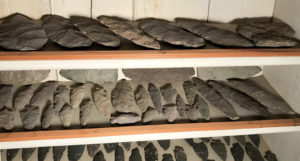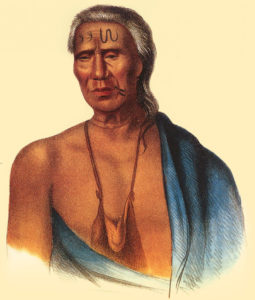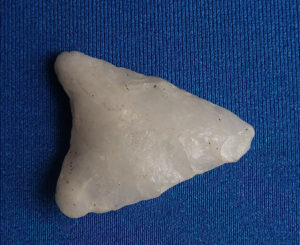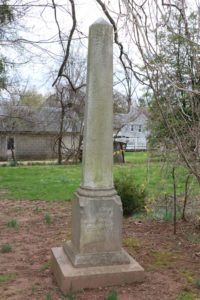Hunterdon County’s Native American Heritage
(Article by Dr. Richard Veit, 2018)

Hunterdon County, located in Northwestern New Jersey, has a rich Native American heritage, stretching back at least 12,000 years. The Deats-Thatcher Collection of the Hunterdon County Historical Society illustrates much of that history.

Present-day archaeologists argue that the first American’s, ancestors of today’s Native Americans, arrived in North America 13,000 years ago. The exact timing of their arrival is much debated; however, strong genetic and linguistic evidence points to a migration from northeastern Asia. The climate of North America during this time period would have been quite different from what it is today. The last major wave of glaciers, the Wisconsin Glacier, was retreating. It had covered much of northern New Jersey, and areas south of the glacier are believed to have had tundra-like environments. A category of large mammals, called megafauna, including mastodons and mammoths, which once roamed the landscape was going extinct. Distinctive projectile points with fluted sides, called Clovis Points, characterize archaeological sites from this earliest phase of human occupation. They are reminders of a time when these first Americans supported themselves by foraging and hunting.

During what archaeologists call the Archaic Period (8,000-1,000 B.C.), the climate warmed, and forest covered much of the state. A foraging and hunting lifestyle remained common but was augmented by fishing and the collecting of shellfish along the shore. Populations grew. New stone projectile point types developed. They were generally made from local stone including chert, jasper, quartzite, and argillite. Hunterdon County was especially rich in argillite tool stone. Woodworking tools like axes, adzes, and gouges appear in the archaeological record, evidence that Native Americans were actively using the resources of the forest. Evidence for longer term settlements is present. Near the end of the Archaic period new containers, stone bowls and eventually pottery appear. In some parts of the state evidence for burial ceremonialism is found.
Archaeologist call the final prehistoric period of Native American occupation the Woodland Period (1,000 B.C.-1600 A.D.). It saw increased use of pottery, a greater emphasis on crops such as corn, beans, and squash, and the introduction of the bow and arrow—previous hunters had employed a tool called the atlatl or spearthower that allowed them to forcefully throw darts or spears great distances. The Woodland Period saw the establishment of more permanent settlements, with wigwams and in the upper-Delaware longhouses. These people were the direct ancestors of the modern Lenape or Delaware people. Archaeological sites across much of Hunterdon County reflect this period.
Finally, beginning in the late 17th century, European traders and settlers began to visit Hunterdon County. Native American populations were greatly impacted by disease and disrupted by the new technologies and belief systems brought by the Europeans. Some Lenape sold land to the new settlers, many moved away, but others remained behind, living by, trading with, and in some cases working for their new neighbors. They often faced intense prejudice and discrimination. Nonetheless, some of their descendants remain.

Even today, traces of Hunterdon County’s Native American history can be found on the landscape. Rich deposits of argillite once quarried by Native Americans as raw material for tool making abound. Places on the landscape retain their ancient names and remind us of those who came before, farmers plow up projectile points and axes in their fields, archaeologists have documented numerous sites in the county, and a monumental marble shaft in Flemington’s Case Family Burial Ground commemorates the life of Tuccimuirgan, a Lenape leader from the 18th century whose relationship with the historic Case family is well documented. Hunterdon County’s ancient past is a fascinating topic worthy of further study.
Select Sources on New Jersey’s Native American Heritage:
Custer, Jay, 1996, Prehistoric Cultures of Eastern Pennsylvania. Pennsylvania Historical and Museum Commission, Harrisburg.
Grumet, Robert, 2009, The Munsee Indians, A History. University of Oklahoma Press, Norman.
Kraft, Herbert C., 1986, The Lenape: Archaeology, History, and Ethnography. New Jersey Historical Society, Newark.
2011, The Lenape-Delaware Indian Heritage, 10,000 B.C. to A.D. 2000. Lenape Books, Elizabeth, New Jersey.
Mounier, R. Alan, 2003, Looking Beneath the Surface: The Story of Archaeology in New Jersey. Rutgers University Press, New Brunswick.
The Bulletin of the Archaeological Society of New Jersey
Support for this program is provided in part by a grant from the Astle-Alpaugh Family Foundation. A special thanks to Mr. Bob Sands, Project Manager and consultants Dr. Richard Veit and Dr. Gregory Herman.
